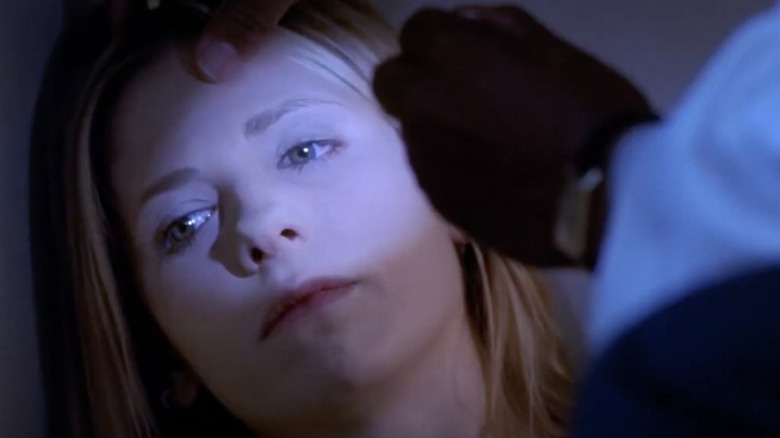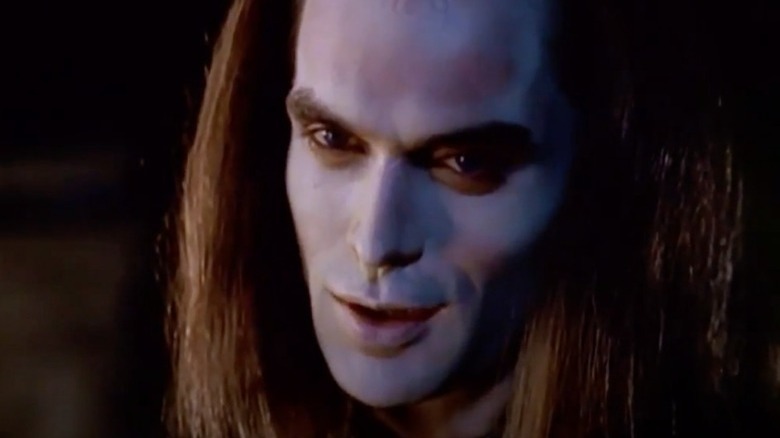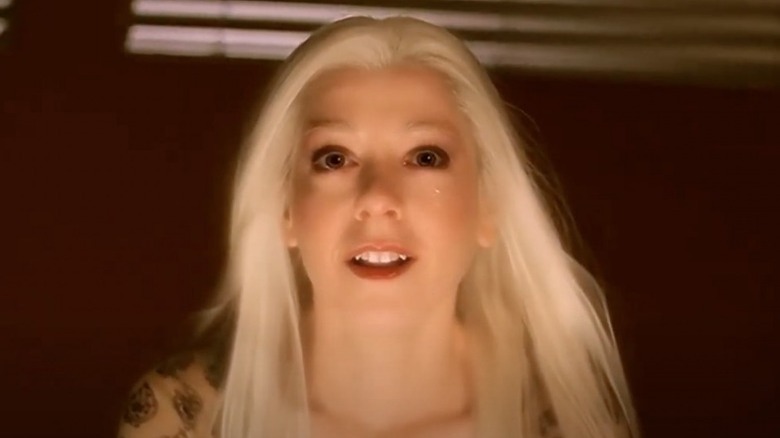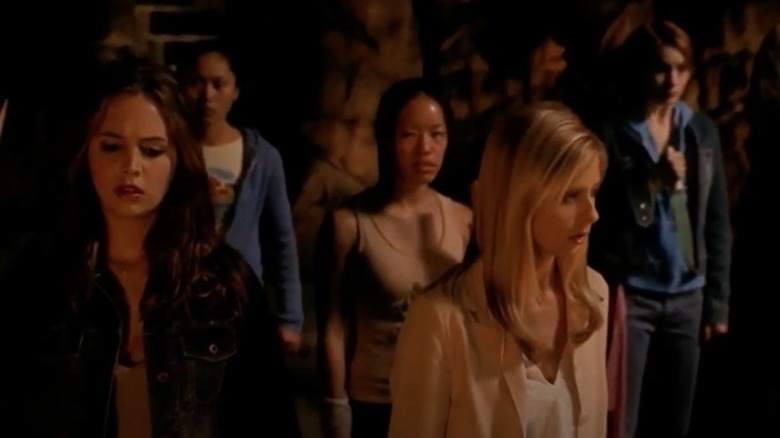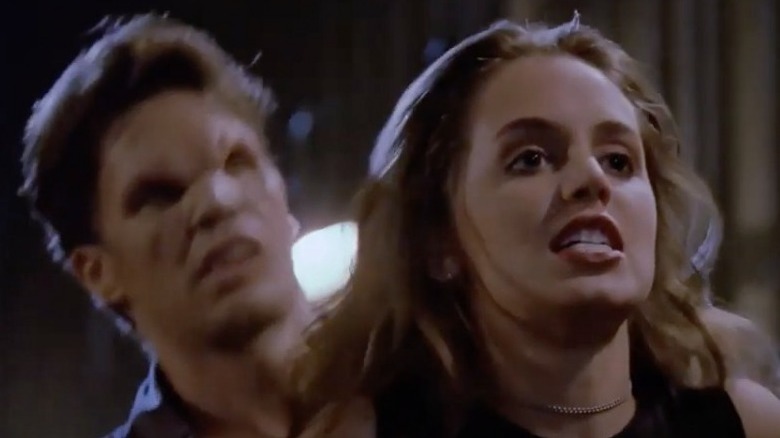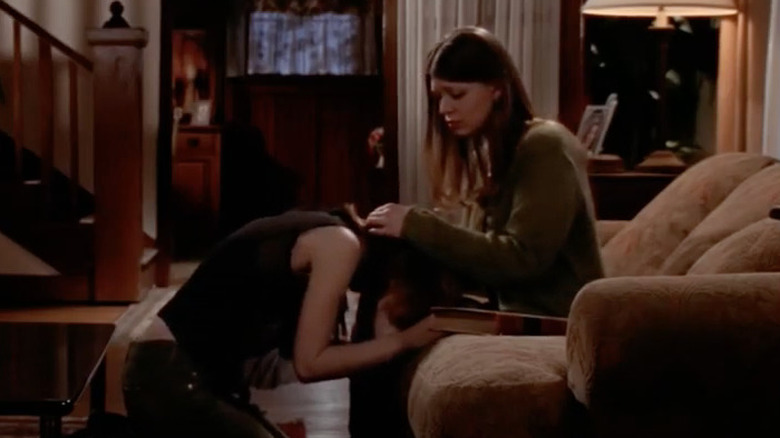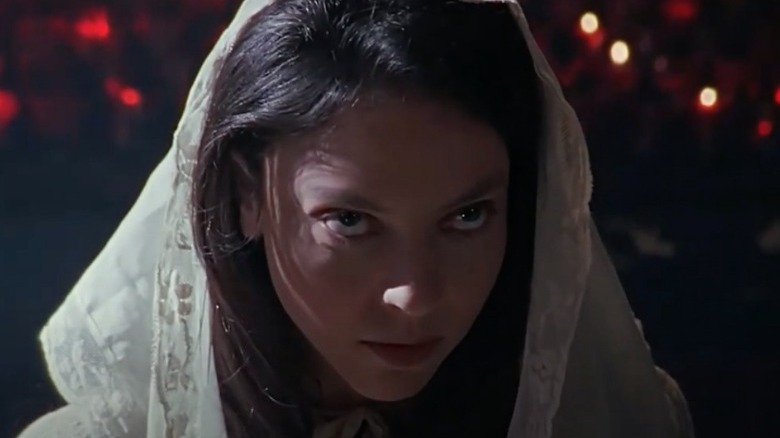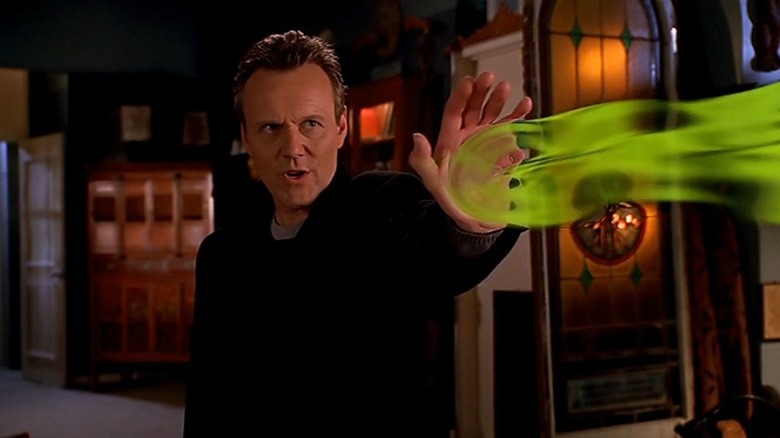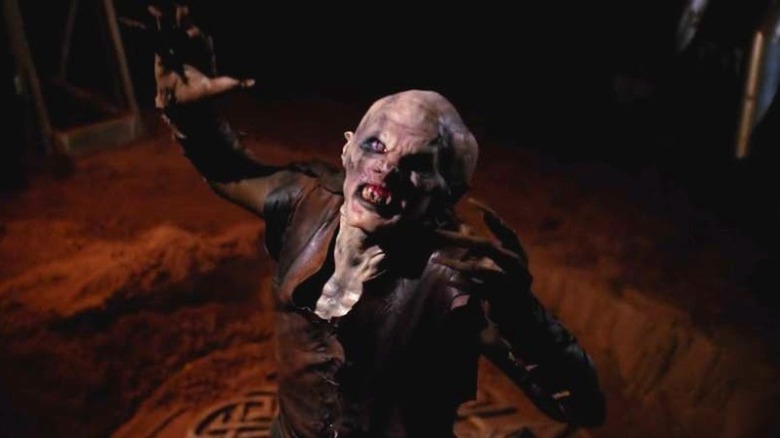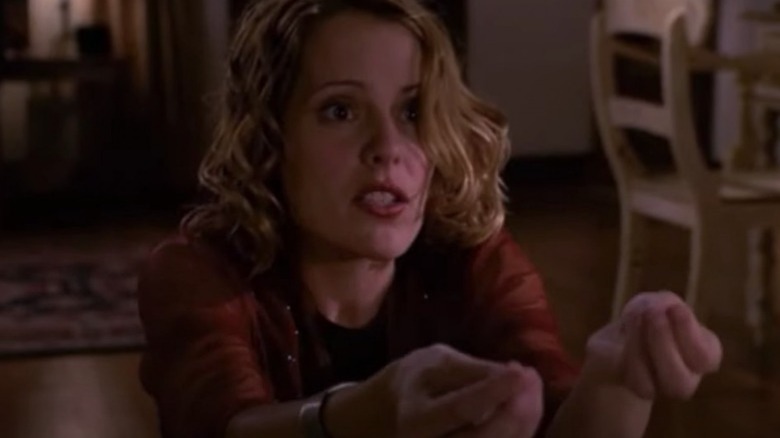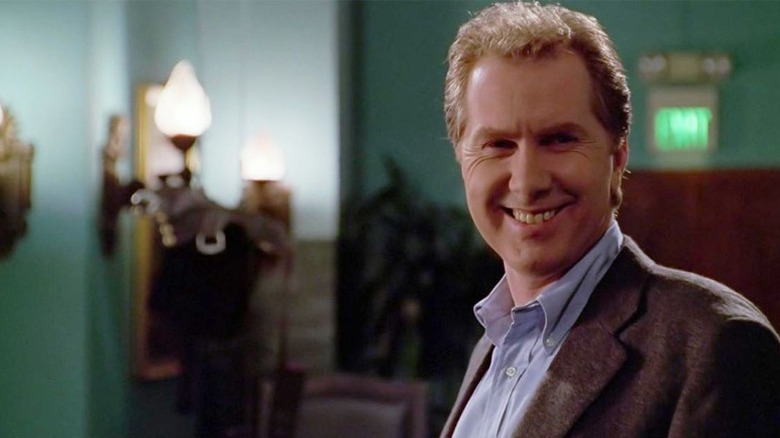Buffy The Vampire Slayer Theories That Change Everything
"Into every generation, a slayer is born," and in March 1997, "Buffy the Vampire Slayer" arrived, establishing a new fandom around a world of vampires, demons, and werewolves. Joss Whedon's "Buffy the Vampire Slayer" centers around Buffy Summers (Sarah Michelle Gellar), a teenage girl who happens to be a vampire and demon slayer. She moves to the idyllic California town of Sunnydale, which just so happens to sit on top of the Hellmouth. Buffy joins forces with her watcher, Giles (Anthony Stewart Head), and her two best friends (aka the original Scooby Gang), Willow (Alyson Hannigan) and Xander (Nicholas Brendon).
Whedon turned a genre on its head to redefine what girl power looked like with a tiny, blonde-haired teenager who could defeat any evil. Part of the show's influence came from its emergence when the internet was becoming a go-to space of information and communication. Initially, the official "Buffy" site hosted a message board, The Bronze, where fans could discuss "Buffy" and develop theories about the different layers of the entire Buffyverse (via CNN).
Some theories have been accepted as canon, with the fans and creators agreeing that it's part of the universe, while others are a bit more out there. So, whether you've already got a concept that you're curious about (that it must be bunnies) or are just starting to dive into this rabbit hole, read on to discover the "Buffy" theories that change everything. However, be warned — there are spoilers are ahead.
Buffy is hallucinating the Hellmouth
"Normal Again" makes both Buffy and fans question everything they know about her life when she is hit with poison that makes her hallucinate. Buffy falls into a fantasy where her younger sister, Dawn (Michelle Trachtenberg), doesn't exist, her mother, Joyce (Kristine Sutherland), is still alive, and she's a patient in a mental hospital. The episode alternates between Buffy fighting demons in Sunnydale and her confinement in the mental hospital, where she has schizophrenia and hallucinates about being a vampire slayer.
The episode aired towards the end of Season 6, and fans quickly latched onto it. Viewers were left questioning the reality of Sunnydale as much as Buffy was, particularly since it ends ambiguously with Buffy still in the mental hospital. Many viewers on Reddit have adopted the theory that this episode is true and the whole series is Buffy's hallucinations from a psych ward.
For example, Reddit user u/theotherghostgirl lays out a detailed take on how all of the characters in Buffy's world would translate into a mental hospital. However, others have argued that whether this is all in Buffy's head or not, it doesn't make the power of the series any less real, as noted in a recap by The A.V. Club. Whether you support this theory or not, one can't deny the unsettling power of this episode, which adds a layer of uncertainty to the world of Buffy and her friends.
Dawn caused Joyce's death
The Season 5 episode "The Body" is unlike any other in "Buffy the Vampire Slayer." In fact, The Atlantic once argued that it's unlike any other on television. Buffy comes home to find her mother, Joyce, lifeless on their couch. Earlier in the season, Joyce discovers that she has a brain tumor, which is removed, but in "The Body," she dies from a brain aneurysm.
Whedon told Metro that he started planning Joyce's death during Season 3, but the fact that the character's death occurs in Season 5 got fans speculating about the true origins of her passing. After all, this season introduces viewers to Dawn, Buffy's younger sister, who literally appears out of nowhere. Dawn is a human form of "the key," which unlocks portals to other dimensions, and a group of monks implanted Buffy, Joyce, and everyone else with memories of Dawn so she can be under Buffy's protection.
Some "Buffy" fans on Reddit link Dawn's arrival with Joyce's departure. The theory supposes that perhaps it isn't coincidental that Joyce gets a brain tumor when she does, as her brain might have been overwhelmed by the influx and implantation of memories of Dawn. Buffy, meanwhile, could have been unaffected because, as the slayer, she isn't just a mere mortal. Additionally, Dawn is created by magic, which is rooted in balance — if you create life, then you must take one as well.
Dracula helps make Dawn
The premiere of Season 5 introduces viewers to one very old character and one very new character with Dracula and Dawn. Meeting Dracula is about as A-list as it gets for a vampire slayer, so Buffy is immediately starstruck. She's actually more than starstruck, as she falls under Dracula's spell and even lets him drink her blood. The episode ends with the reveal of Buffy's baby sister, leaving viewers to wonder how such a significant moment could occur in this stand-alone, borderline ridiculous episode.
Reddit user u/zixx posits that Dracula was "sent by the monks to get some of Buffy's blood in order to create Dawn" and notes that a hooded monk is seen in the graveyard when Dracula first appears. Blood is a motif throughout Season 5, which focuses on family. When Buffy sacrifices herself at the end of the season, it's because she and Dawn share the same blood. Viewers see this in the episode "Blood Ties," when Dawn discovers that she's the key, and Buffy makes a blood oath with her to show that they're sisters no matter what. However, the Dracula theory could bring the season full circle by suggesting that Dawn was created from Buffy's blood, and ultimately, it's Buffy's blood that protects Dawn when Buffy sacrifices herself.
Willow killed all the slayers
In Buffy's world, something that sets her apart from previous slayers is her support network. In the past, slayers would walk alone, fighting in the shadows and hiding from others. At the beginning of the series, Willow becomes an essential resource for Buffy because she uses her computer skills to find necessary information and spells. Later, Willow becomes a powerful witch in her own right.
In the series finale, Willow steps up to help Buffy one more time and cast a spell to turn all the potential slayers into actual slayers so they can join forces to fight the uber vampires. However, she's cagey about the details of this spell, and one interpretation is that Willow infects the potentials with the shadow demon used to create the first slayer in order to activate all of them.
However, Reddit user u/flagnut1 has a different idea because the only way viewers have seen another slayer activated in "Buffy" is when Buffy dies. If there's no way for a slayer to emerge without the death of the previous one, then perhaps Willow "causes a small brain hemorrhage or heart attack in every single slayer, in order, in a chain reaction, killing them ALL, but following it with a quick restorative to bring them back to life." Since the previous season ends with Willow transforming into Dark Willow and she struggles with her addiction to dark magic, it's not implausible that she might perform a spell like this.
The Whedonverse is real
Joss Whedon is known as a mastermind of foresight. He plotted Joyce's death years before it happened, and "Buffy" is rife with hints of things to come. As such, it's no surprise that the intricate connections in the Buffyverse extend far out into spaces outside of Sunnydale. Some suspect that "Buffy," "Angel," "Cabin in the Woods," "Firefly," and "Serenity" all exist in the same universe or Whedonverse.
In fact, the idea that the events of each show or film are connected has been dubbed the "Universal Slayer Theory." This visual aid illustrates the concept, stating that Buffy's finale, which activates all the new slayers, triggers a chain of events that lead to the awakening of the Senior Partners in "Angel" and, consequently, the apocalypse in "Cabin in the Woods." "Firefly" takes place in a future after "Cabin in the Woods," and many believe that River Tam (Summer Glau) is a new form of the slayer.
In typical Whedon fashion, these connections can't just be whittled down to a few lines, so check out Quinn Donato's detailed explanation on Medium of the events and timelines. You might even want to prepare yourself for a full rewatch of the Whedonverse to see how everything links up.
The slayer line comes from Faith
In many ways, "Buffy" goes where no other show does (or did, at least in the '90s), and that includes killing its protagonist not once but twice. In Season 1, the Master drowns Buffy and, while she's only dead for a few seconds, it's long enough for a new slayer to be called in the form of Kendra (Bianca Lawson). Kendra's tenure as slayer is short-lived since Drusilla kills her in Season 2, which leads to the calling of Faith (Eliza Dushku) as the new slayer.
Faith is Buffy's foil, as she is impulsive, reckless, and always five-by-five. Where Buffy bears the existential weight of being the chosen one, Faith thrives on it. Once Faith enters the picture, Buffy could retire at any time and live as recklessly as Faith because she isn't actually the chosen one anymore.
When Buffy dies once again at the end of Season 5, there's no new slayer called. That's because Faith is still alive and, due to Buffy's first death at the hands of the Master, Faith is the one continuing the slayer line. So, if Buffy dies again but Faith doesn't, no new slayer would be called. The mechanics of the slayer line have been accepted as canon, and some fans have pointed out discrepancies in Season 7 as Buffy continues to believe that her life and death will change the slayer line as it seems that she may not be so special after all.
Faith portended Buffy's sacrifice and Dawn's arrival
Perceptive "Buffy" fans have spotted various hints of both Dawn's arrival and Buffy's sacrifice that pepper early seasons of the show. Some of the biggest clues come from Faith when she appears in Buffy's dream in the final episode of Season 3. Part of a slayer's power is prophetic visions, so it's not surprising that Buffy would have dreams of another slayer foretelling the future, even if she doesn't know what it means. "Little Miss Muffet, counting down from 7-3-0," Faith notes as she steps into a spot of sunlight, underscoring that she's illuminating a truth.
While neither Buffy nor the viewers know what she means, it all becomes clear-ish in Season 5. In the episode "Real Me," a homeless man who can see that Dawn is the key calls her "curds and whey," which comes from the "Little Miss Muffet" rhyme, and when Buffy sacrifices herself at the end of the season, fans have observed that it's exactly 730 days from her graduation day dream with Faith. The hints continue in Season 4, when Faith appears in another one of Buffy's dreams in the episode, "This Year's Girl." In that dream, Faith tells Buffy, "little sis coming, I know. So much to do before she gets here." Like many dreams, this out-of-context statement both makes sense and doesn't, but with the arrival of Buffy's "little sis" in the next season, it takes on a whole new meaning.
Tara was a sacrifice for Buffy
While "Buffy" revolves around death, a few have stood out as particularly devastating. Joyce is one, and Tara (Amber Benson), Willow's girlfriend, is another. Tara is killed by a rogue bullet shot by Warren, which triggers Willow's descent into total darkness as she transforms into Dark Willow to avenge her lover's death. While many fans decried Tara's death as avoidable (also as perhaps contributing to the "bury your gays" trope), others have a theory that it was necessary.
Buffy Boards user Josh the Writer proposes the "Osiris Theory," which is that a sacrifice was required after Willow resurrected Buffy at the start of Season 6. When Willow brings Buffy back from the dead, she sacrifices a deer while calling upon Osiris, the Egyptian god of death. However, perhaps that wasn't a big enough offering to the god of the underworld, particularly when trying to bring back a powerful slayer who died by magical means.
Magic in "Buffy" is founded in the balance of give and take, and one can never perform a spell, particularly a dark one, without paying a price. Tara is a powerful witch, and so perhaps she is the true offering for Buffy's return to life as she's more equal to Buffy than a deer. Whether you subscribe to this theory or not, it doesn't quite alleviate the pain of Tara's death.
Drusilla was a potential slayer
Everyone has their favorite villain on "Buffy the Vampire Slayer," and for many folks, Drusilla (Juliet Landau) is at the top of the list. Drusilla first appears in Season 2 with Spike (James Marsters), ready to wreak havoc and stir things up as a Sid and Nancy-type couple. Initially, Drusilla is weak, flighty, and sensitive, often prone to splitting headaches and visions of the future. However, she regains her vampiric strength thanks to a blood ritual with her sire, Angel/Angelus (David Boreanaz), and she transforms into a powerful foe.
Through flashbacks, viewers see Drusilla as a human before Angelus turns her into a vampire. She was a young Catholic woman with psychic abilities as she would have visions of the future. Angelus becomes obsessed with corrupting and degrading the innocent Drusilla. He eventually does so by posing as a priest during her confession of her visions, which she thinks are making her evil. Vampire slayers have the gift of prophetic visions, so Reddit user u/Bella-Lugosi wonders if perhaps Drusilla's second sight indicated that she was a potential slayer. It would add another layer to Angelus' obsession with her, and it is certainly hard not to imagine the epic tale of Drusilla, the vampire slayer.
Giles is a Time Lord
While the connections between "Buffy" and the Whedonverse are clear, some fans believe that they extend outside of Whedon's worlds as well. A number of fans have made the case that both "Buffy" and "Doctor Who" exist in the same universe.
At the end of Season 6, Giles uses magic to combat Dark Willow. However, she retaliates, and Giles is soon on the brink of death. Miraculously, Giles doesn't die, and while it seems to be because Willow stops using black magic to destroy the world, some fans believe it's because he's a Time Lord who's regenerated (while keeping his appearance). Others think it goes beyond Giles and that Buffy too is a time lord (seeing as she, you know, is always dying and coming back to life).
After the series finale of "Buffy," Whedon resurrected the vampire slayer (again) in a new form: a comic book. The Dark Horse "Buffy" comic was overseen by Whedon, per MTV, and picks up after the events of the show's finale, so its events are considered canon. In the "Buffy" comic, the connection with "Doctor Who" seemingly becomes explicit, as fans on Reddit pointed out that the Tenth Doctor and Rose appear in one of the panels. While some think this may have just been a fun easter egg from the comic book artists, others believe it's a sign that there are Time Lords in the world of "Buffy."
Anya didn't actually die
There are many choices of favorite characters to pick on "Buffy," but for a lot of fans, the best one of all is Anya (Emma Caulfield), the former vengeance demon and lifelong capitalist. Anya comes to Sunnydale as a protector of scorned women, summoned by Cordelia (Charisma Carpenter). Things don't go as planned, either on-screen or off, as Anya gets stripped of her powers and turned into a mortal, while Whedon realized that audiences responded well to her character, so he made Anya a part of the Scooby Gang, per TV Guide.
Anya goes on a rollercoaster as she goes from vengeance demon to mortal, back to vengeance demon, and finally ends up as a mortal once again. She ultimately sacrifices her life to help Buffy and the gang, which is an arc that takes the vindictive, selfish character fans first met to a memorable conclusion.
Many were devastated to see Anya killed, but Reddit user u/CavalierTunes wonders if we can be sure that Anya died. While the series implies that she's stripped of her vengeance powers in the Season 7 episode "Selfless," it's not explicitly stated. Perhaps D'Hoffryn took away some of Anya's powers but not all? u/CavalierTunes points to other moments in Season 7 that indicate Anya may be more powerful than we think. So, maybe she wasn't killed at all but instead is just hanging out under the rubble, waiting to be discovered by Xander — or a perceptive "Buffy" fan.
The ubervamps were really, really hungry
Every season of "Buffy" features a new Big Bad that torments the slayer, her friends, and all of humanity, if it's big and bad enough. Season 7 sees Buffy fighting the biggest villain of all, The First, aka the original evil. The First is incorporeal, able to take the body of anyone who has died, human and demon alike, and it harnesses its power in the flesh by releasing the Turok-Han or ubervamps. These are the first vampires, a primordial evil unlike any vampire Buffy has ever faced before.
The First uses Spike's blood to summon a Turok-Han to Earth. When Buffy meets this ubervamp, it nearly kills her in a way viewers have hardly seen before other than when Buffy meets Caleb (Nathan Fillion), a human incarnation of The First. However, at the end of the series, when an army of ubervamps descends upon Buffy and the potentials-turned-slayers, the slayers are all able to fight the vamps in a way that Buffy couldn't when she first met the Turok-Han.
Some fans have noted that the slayers were at an advantage. Unlike the original Turok-Han, who got to feast on Spike's blood, this army of vampires hasn't fed in centuries. Hungry, weak, and probably a bit hangry, the ubervamps are no match for this army of slayers, or at least, they're a bit more equally matched.
Anya invented capitalism
In the chaotic world of Sunnydale, there are a few things that remain constant, like Anya's hatred of bunnies and love of money. While there is much about humanity that the former vengeance demon doesn't understand, greed and profit aren't on the list. Anya finds her safe space in the world of turning a profit as she teams up with Giles to run the Magic Shop and tries to change the rules of the game of Life to "trade in the children for more cash."
Anya's love of money runs deep, and Reddit user u/zlpatnegam suggests that it may go beyond being just something shiny and exciting about humans that draws in Anya. In a flashback, viewers see the human Anya, then known as Aud, before she becomes a vengeance demon. She tells her husband, Olaf, about what they can do with their excess rabbits (making one wonder what trauma turned her against her once-beloved pets) and expresses the basic idea of capitalism.
Olaf laughs off her idea, dismissing her as a foolish woman, but u/zlpatnegam imagines Anya after she's become a vengeance demon, using her powers to create this world of capitalism she once envisioned. It's more of a fun theory than anything, but it's not hard to imagine Anya in this way.
The Mayor stopped the Master
The Master (Mark Metcalf) is the first Big Bad of the series, and he's a pretty significant one as he manages to kill Buffy. When Buffy meets the Master, he's escaped the mystical barrier that has trapped him for decades and has recently broken through the Hellmouth. Season 1 focuses on The Master's growing power as he tries to unleash the apocalypse, but ultimately, he's no match for the Slayer (and friends). Buffy defeats the Master and moves on to bigger and badder evils, like the Mayor in Season 3.
Both the Master and the Mayor have the same goals — to kill a lot of people, become all-powerful, and end the world. But "Buffy" fan Merlin theorizes that there's more to this story than viewers may realize and that the Mayor is the one who originally imprisoned the Master. The Master tries to harness his power in 1936, but his ritual is disrupted by an earthquake, which causes him to be swallowed by the Hellmouth.
Merlin argues that there's one supernatural being powerful enough to have caused this earthquake and confined the Master, and that's the Mayor. It may seem strange for the Mayor to protect the world from the Master's rise, but perhaps he needed to continue gathering the sacrifices he needed for his own ascension. Merlin goes into elaborate detail about the theory, which helps it seem pretty convincing.

